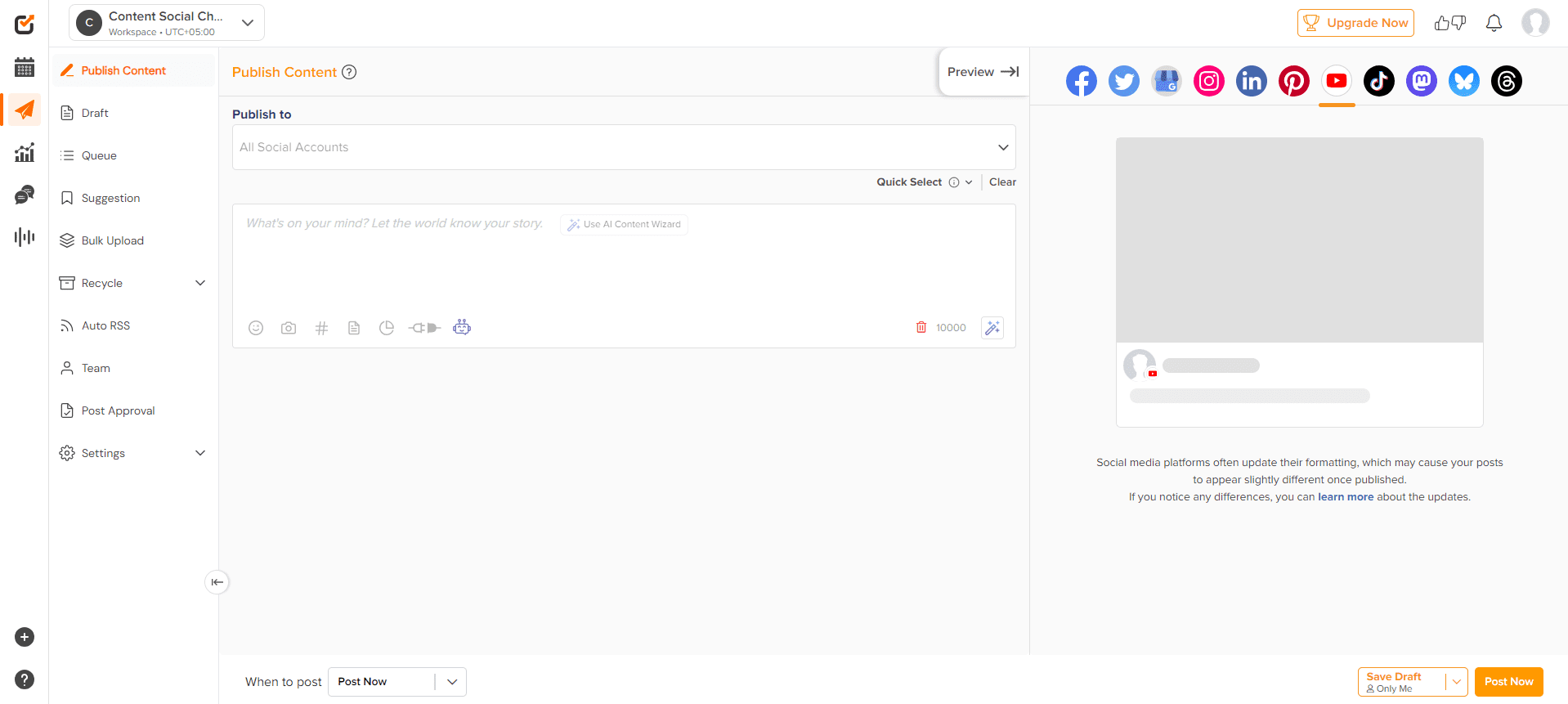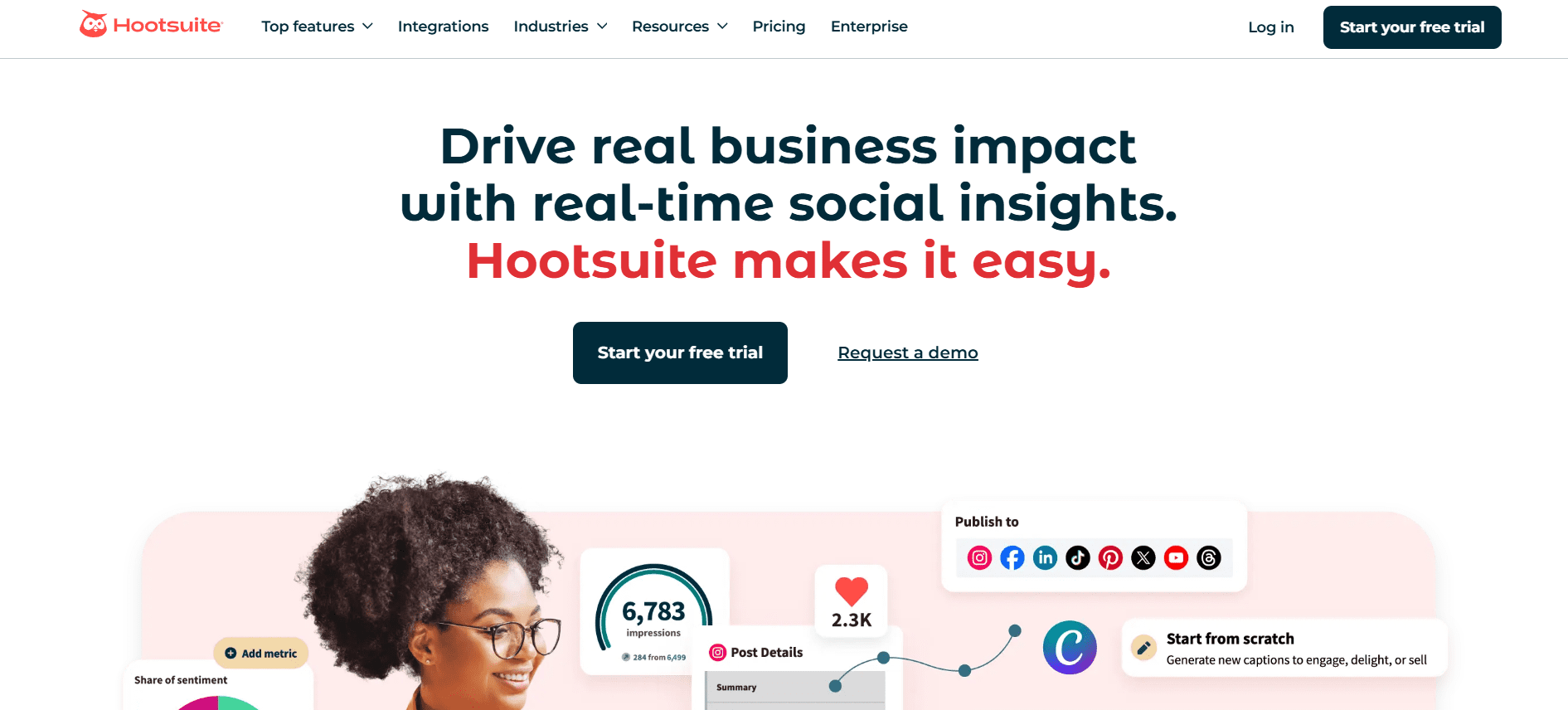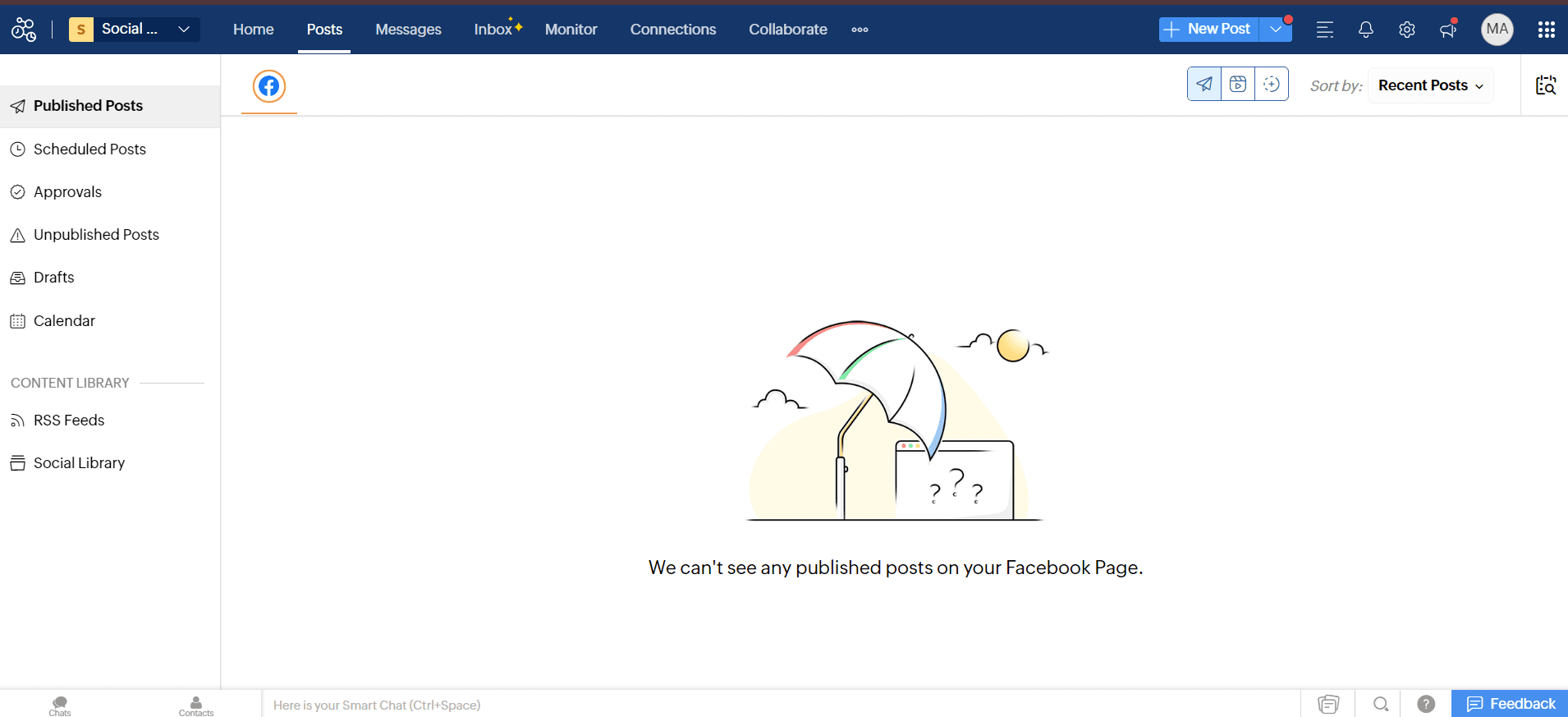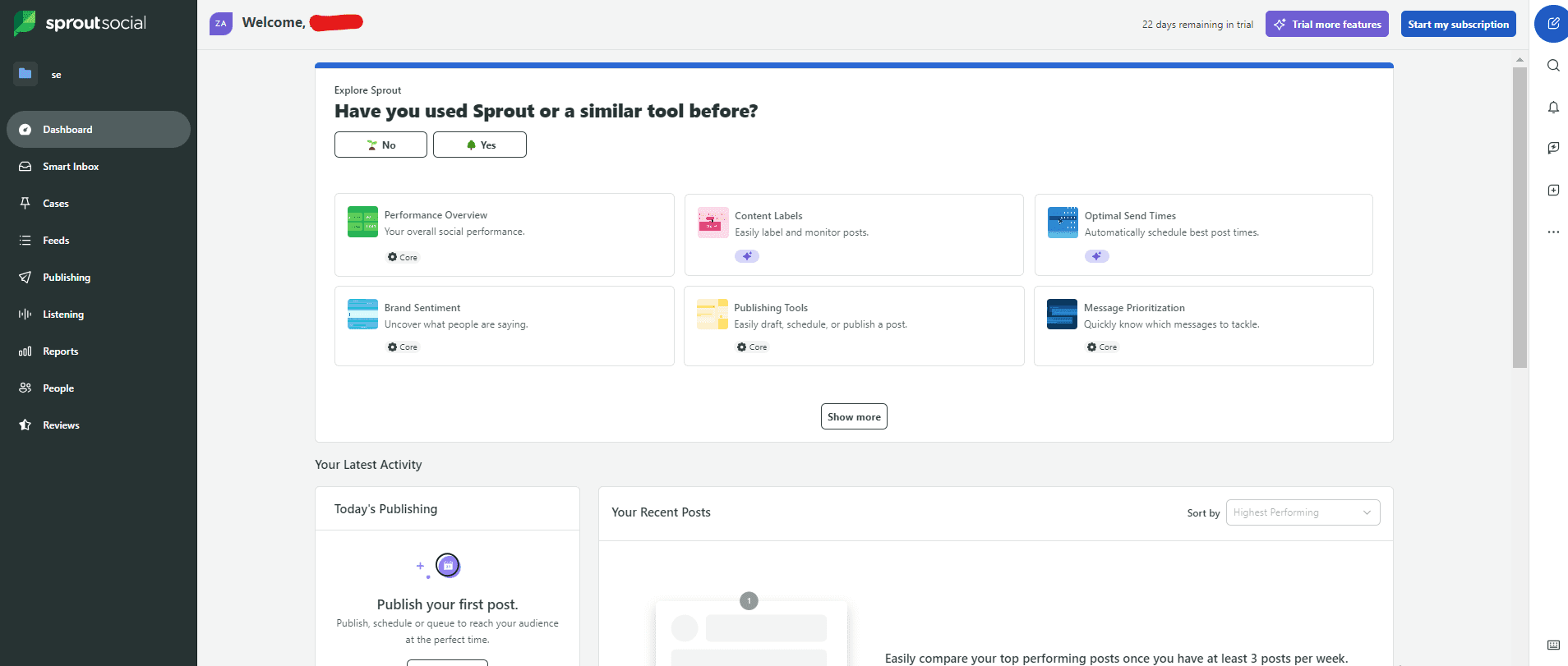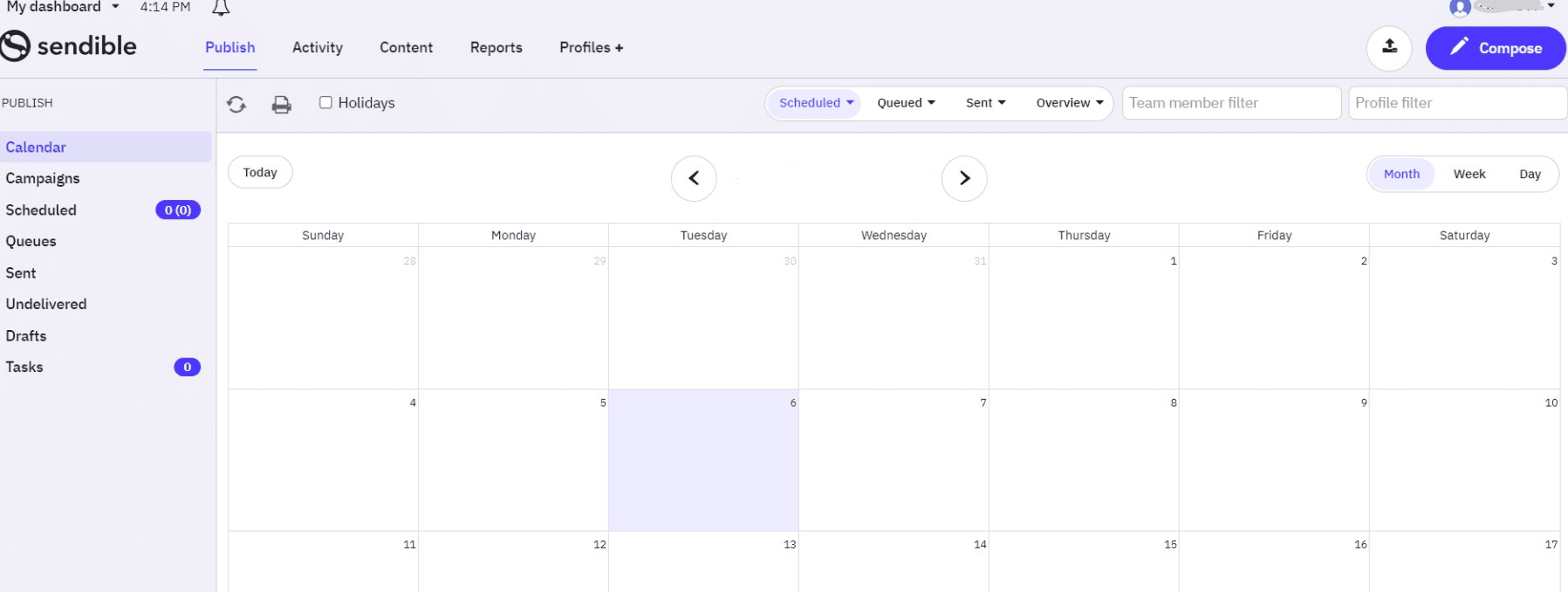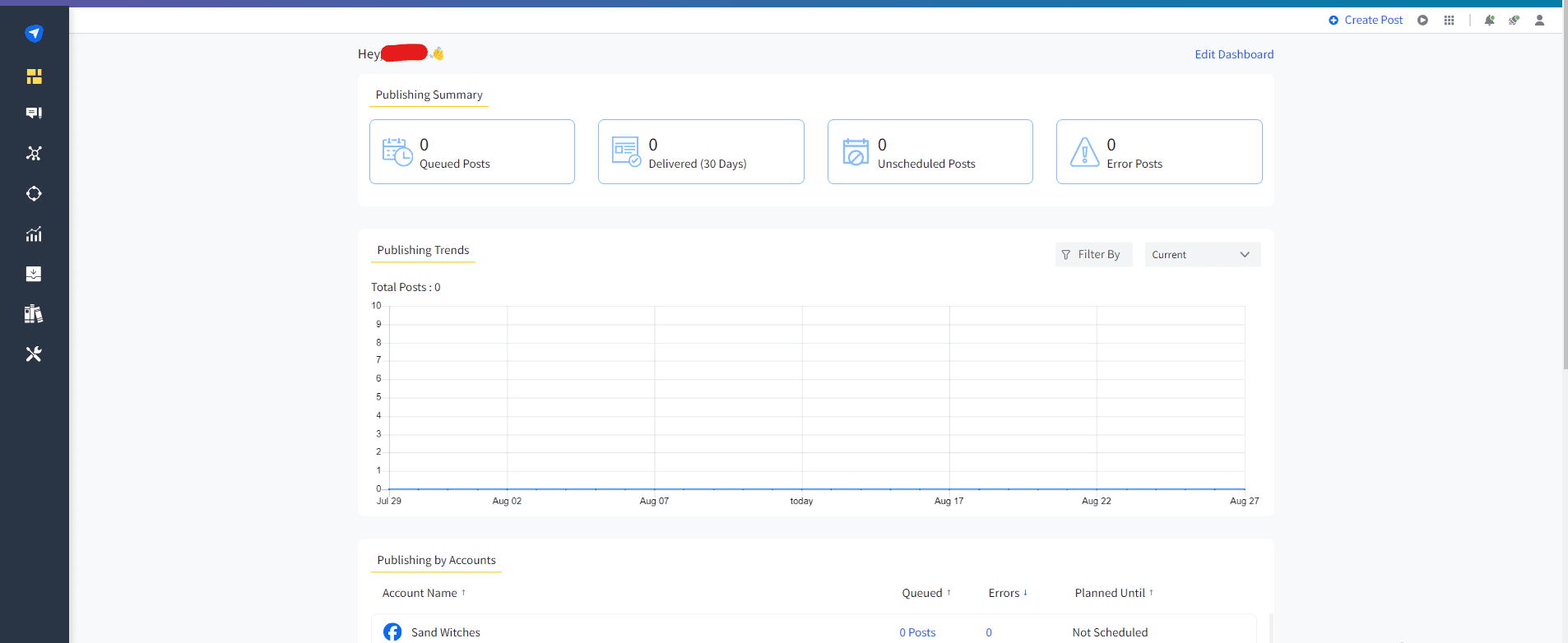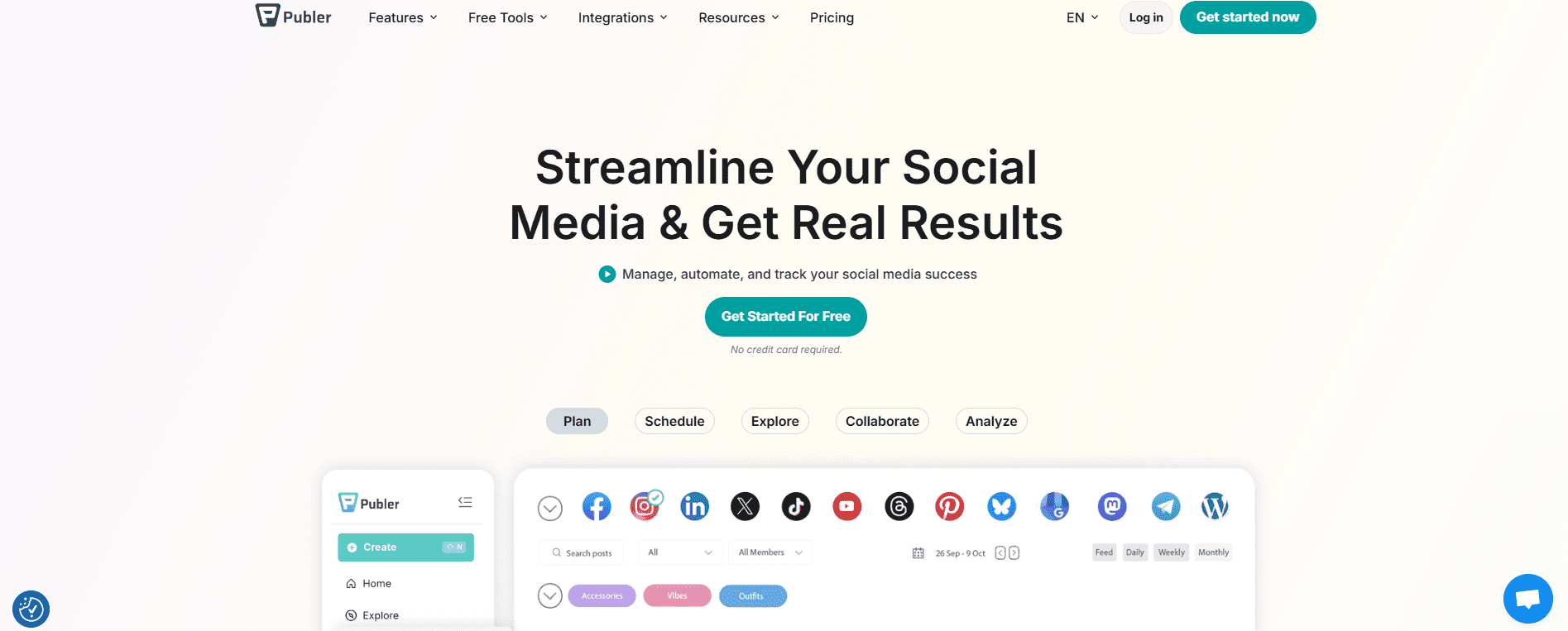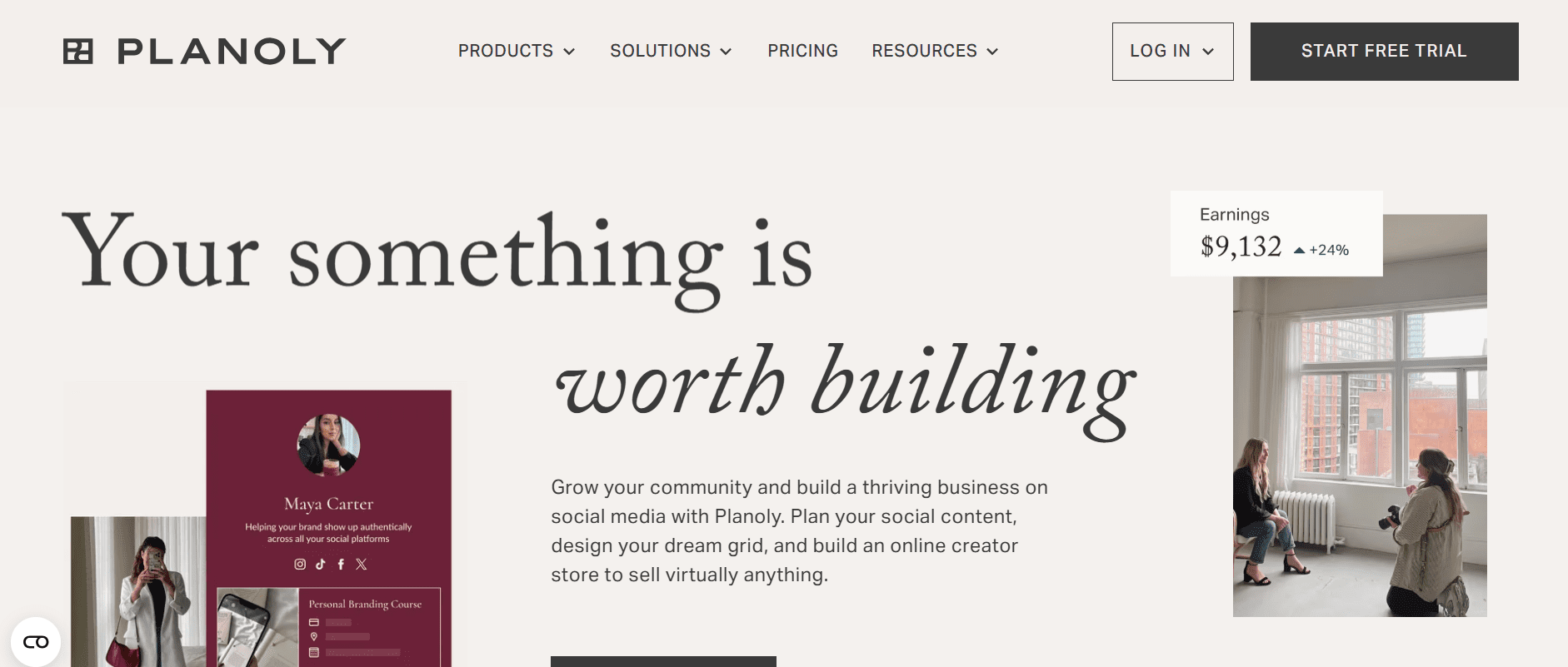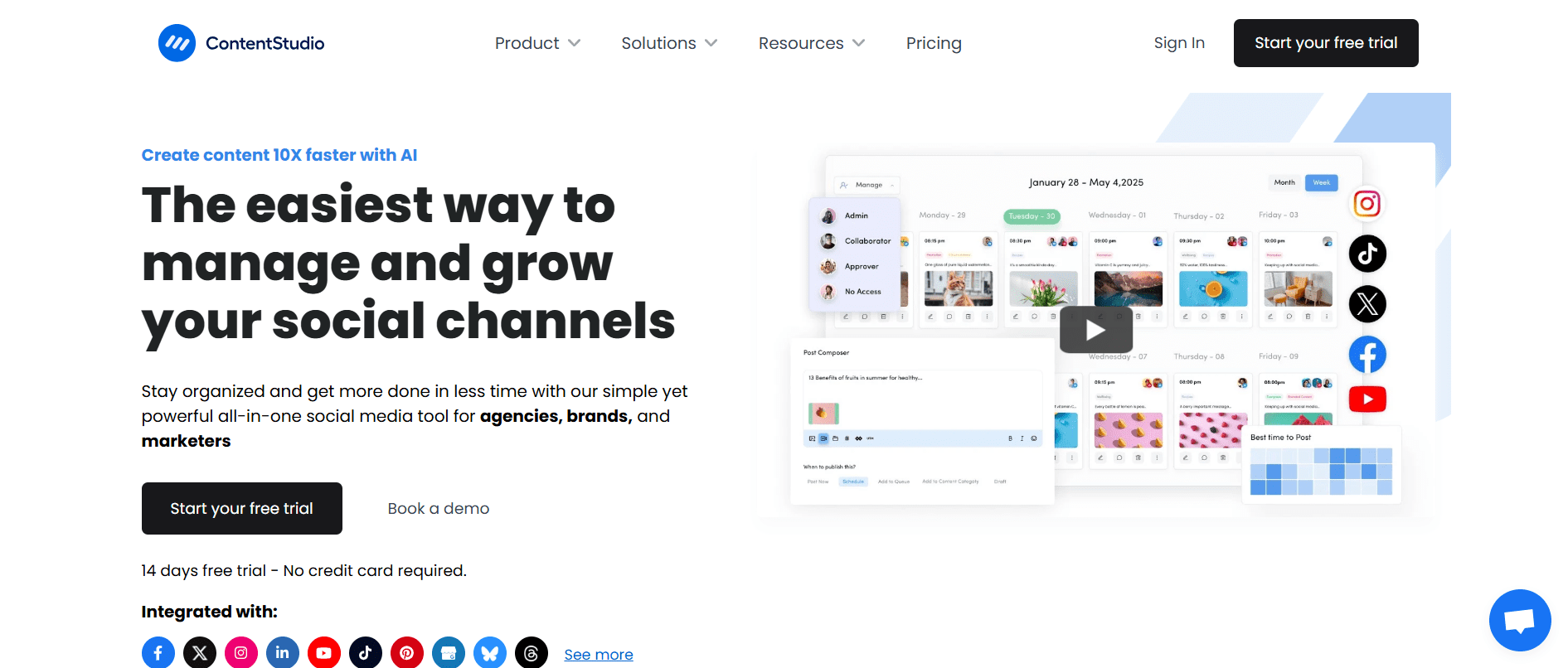If you have been using Pallyy for some time now, you know it does what it does best. You get easy scheduling, an intuitive interface, and great analytics.
That being said, social media is too fast-moving to remain committed to one tool because it’s “good enough.”
New platforms spring up overnight, algorithms change before you’ve even gotten to your second cup of coffee, and your content strategy requires more than a posting calendar.
Short Summary
- Pallyy is known for its clean design and easy scheduling but has limitations in users/accounts on lower tiers, high price jumps, and missing advanced features like social listening or AI optimization.
- Many users seek alternatives for better scalability, broader platform support, richer analytics, and more affordable pricing.
- Social Champ stands out for its multi-platform support, AI content tools, social listening, deep analytics, and strong collaboration features at affordable rates.
- Other notable tools include Hootsuite, Buffer, Zoho Social, Sprout Social, Sendible, SocialPilot, Later, Vista Social, Publer, OnlySocial, Planoly, and ContentStudio.
Whether you’ve grown out of Pallyy’s functionality, reached a plateau with its constraints, or simply want to check out what’s new on the market, you’re in the right spot.
I’ve gathered 13 reliable Pallyy alternatives, each with its own pros, cons, and price tag, so you can discover the one that really works the way you do (and maybe even simplifies your life).
Let’s get started.
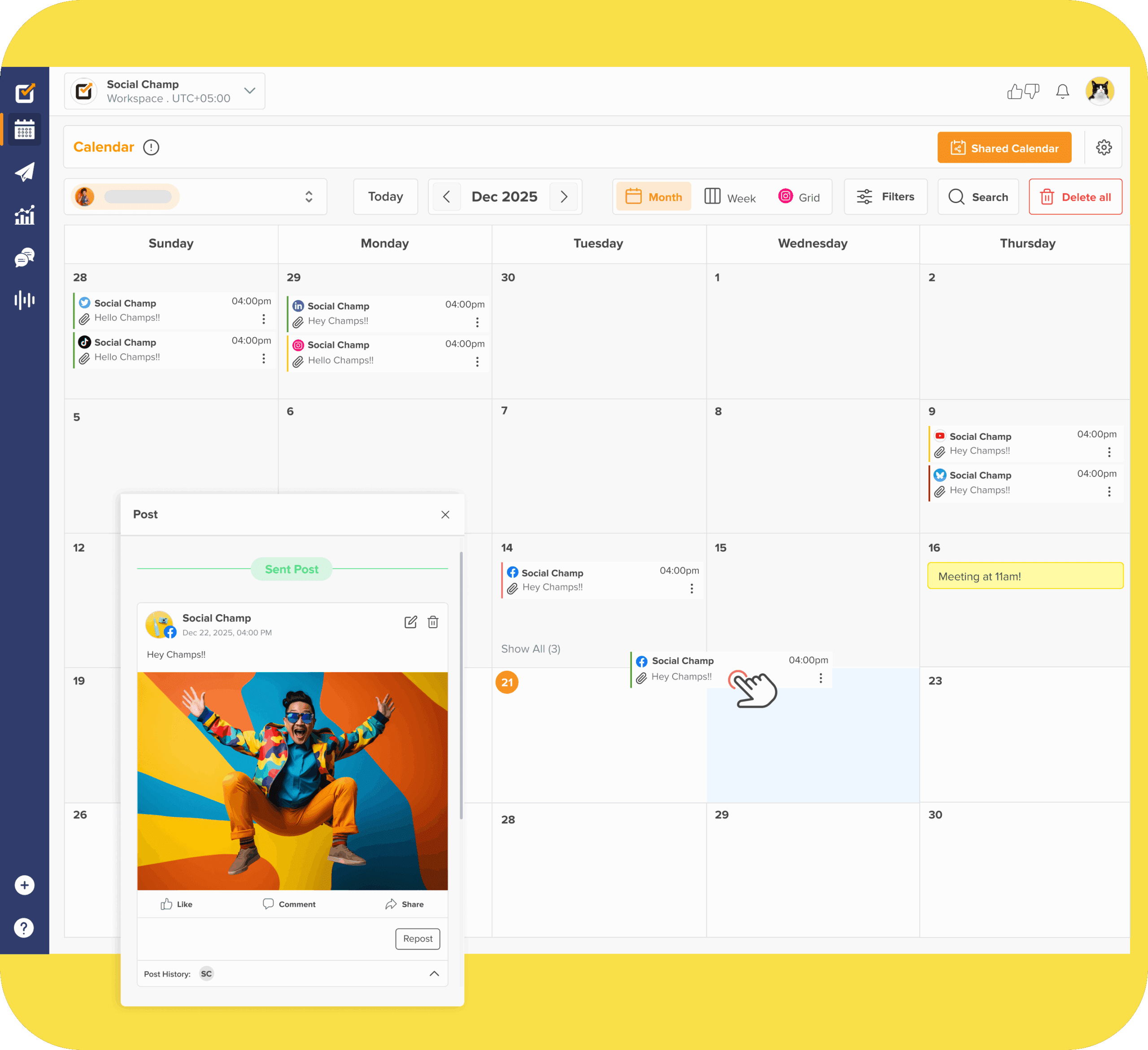
Your Audience Won’t Wait for You to Catch Up!
Social Champ keeps you posting, engaging, and converting, while others are still figuring out what to post next.
Why Users Seek Pallyy Alternatives?
Pallyy has a loyal following for its clean design and straightforward scheduling, but it’s not a perfect fit for everyone, just like many others!
As your social media needs evolve, you might find yourself bumping into its limits. Here are the common reasons users start looking elsewhere.
-
Limited Users and Accounts in Low-Cost Tier
Pallyy’s entry-level strategy is inexpensive for its features, but it’s limited enough that users quickly burn through it.
Its lowest tier costs $25/month in which you only get 1 user and 1 social account, which is a limit that even a small business owner would find unfair.
You can always get more social accounts while still using their “Pay As You Go” tier, but you will have to pay an additional $25 for more social accounts and $29 to add new users.
-
High Price Jump
The transition from the entry plan to a top-tier plan can be intimidating, especially for new agencies or freelancers.
While Pallyy’s paid plans offer additional features, the price increase at times is disproportionate to the benefits, forcing users to look elsewhere for more tools with mid-tier plans.
-
Lack of Features
Even on its higher-end levels, Pallyy focuses on content scheduling and reporting but leaves out more advanced functionality like social listening, rich competitor analysis, or AI-based post optimization.
If marketers prefer to slice through all of that in one dashboard, this can be a huge turn-off.
Featured Article: Everything You Need to Know About Postly Pricing
Comparative Analysis: Pallyy vs. Its Alternatives
Here we are placing Pallyy alongside its leading competitors and putting major distinctions in features, pricing, and user experience into perspective.
| Tool | Starting Price | Key Features |
|---|---|---|
| Pally | $25/month | Schedule & publish, social media analytics, social inbox, link in bio |
| Social Champ | $4/month | Publishing and scheduling, social media calendar, social listening, engage, analytics |
| Hootsuite | $99/month | Publishing, analytics, social listening, customer support, ad management |
| Buffer | $5/month | Content creation, publishing, analytics, engagement, collaboration |
| Zoho Social | $10/month | Publishing, monitoring, analytics, and CRM integration with the Zoho suite |
| Sprout Social | $199/month | Engagement, analytics, content planning, customer care |
| Sendible | $29/month | Scheduling, sourcing content, engagement, collaboration, analytics |
| SocialPilot | $25.50/month | Scheduling, analytics, client management, white-label reporting, team collaboration |
| Later | $16.67/month | Scheduling, analytics, team collaboration, AI assistant |
| Vista Social | $39/month | Planning and publishing, media tools, engagement tools, AI assistant, content finders, reports |
| Publer | $4/month | Post scheduling, calendar view, openAI integration, link in bio |
| OnlySocial | $29/month | Scheduler and planner, sales automation, link in bio |
| Planoly | $16/month | Visual content planning, Instagram scheduling, basic analytics, and drag-and-drop calendar |
| ContentStudio | $19/month | Multi-channel publishing , content discovery, AI caption generator, analytics and influencer tracking |

Why Settle for Less When Social Champ Does It All?
From AI content creation to advanced analytics, Social Champ covers the gaps Pallyy leaves behind, at a price that makes sense.
Top 13 Pallyy Alternatives for 2025
Each of the above-mentioned Pallyy alternatives has something to offer. Here’s a detailed overview of each tool to help you choose the right one.
-
Social Champ

Social Champ’s Dashboard If you have multiple brands or clients to handle and require a social media tool that actually makes things easier for you, Social Champ could be your new best buddy.It’s everyone’s go-to social media tool now, and it’s not hard to see why.
Social Champ merges all the essentials you’d want from a high-end platform, publishing, scheduling, analytics, content calendar, and team collaboration, but packages them all together in an easy-to-use interface that doesn’t bog you down.
It’s also affordable, particularly for small to mid-size teams that require utmost value without the enterprise price.
Key Features
- AI content tools that help you write, reuse, or create idea-striking content when you run out of ideas.
- Content calendar to help you plan and organize weeks’ worth of content in advance.
- Social Listening features to track brand mentions, keywords, and industry trends on multiple platforms, so you stay ahead of the discussions.
- Publish and schedule to all of Facebook, Instagram, LinkedIn, Twitter (X), TikTok, Pinterest, Threads, YouTube, Bluesky, Mastodon, and even Google Business Profile.
- A social inbox where you can reply to comments and messages without having to switch between tabs.
- Clever analytics, including competitor analysis, with uncomplicated, actionable charts and results.
- Workspaces and access based on roles for teams.
- Convenient Chrome extension and mobile apps for managing on the go.
- Integration with apps like Canva, OneDrive, Dropbox, Flickr, Imgur, and more.
Pros
- The interface is very intuitive. Your team won’t need a tutorial to be able to utilize it. But Social Champ does have a free demo in case you need it.
- Social Champ rolls out new features constantly, and the support is extremely responsive.
- The white-labeling and collaboration features are great.
Cons
- Analytics are not available for X due to API issues, which can be a small drawback.
- Advanced features, such as social listening and competitor analysis, are only available on the Growth plan.

Upgrading From Pallyy? Meet the Powerhouse.
Social Champ isn’t just an alternative, it’s the smarter, faster, all-in-one platform that makes every post count across more networks.
-
Hootsuite

Hootsuite’s Homepage One of the most entrenched social media management brands, Hootsuite provides an extensive toolkit designed to handle mid-sized enterprises.
From posting content and team collaboration to paid advertising and monitoring brand sentiment, it addresses almost every area of social media marketing.
Its power and depth come with compromises, both financial and in terms of time to master the platform.
Key Features
- Social publishing and tracking across multiple channels
- Social listening to monitor brand mentions, keywords, and sentiment
- Integrated paid ads management for Facebook, Instagram, LinkedIn, and many more
- App integrations and automations of workflows
- Collaboration features for teams, such as assignments and permission settings
Pros
- Very feature-rich, addressing nearly all aspects of social media marketing
- Designed for large teams and multi-level campaigns
- Consolidates with a large variety of CRMs, ad platforms, and analytics tools
Cons
- Pricing scales up dramatically with additional team members, accounts, or pro features
- Very steep learning curve and kind of unintuitive interface for new users
- Most core features (such as analytics and approval workflows) are reserved for higher-tier plans
- Slow customer support is reported by some users, and minimal hands-on help is provided.
- Lacks more recent features such as AI-driven content suggestions or automatic optimization
-
Buffer

Buffer’s Dashboard An experienced player in the social media management space, Buffer has carved out a niche for itself that prioritizes simplicity and transparency.
It’s especially favored among freelancers, entrepreneurs, and solo marketing departments that need solid publishing tools without the expense (or overhead) of enterprise-grade solutions.
Key Features
- Facebook, Instagram, Twitter (X), LinkedIn, and Pinterest multi-platform scheduling
- A visual content publication queue to pre-plan content and ensure consistency
- Core analytics that give an overview of what’s working
- A clean engagement dashboard for commenting and responding to messages
Pros
- Easy-to-use interface, clean, simple, and not bloated
- Ideal for freelancers, startups, and individuals who need the essentials done well
- Clean and simple pricing plan without upselling or surprise bills
Cons
- Minimal set of collaboration tools
- No social listening
- Basic analytics
- Limited engagement tools
- Limited integrations
- No ad management
-
Zoho Social

Zoho Social’s Dashboard Zoho Social is unique in its native integration with applications such as Zoho CRM and Zoho Desk, which makes it a savvy option for companies already committed to the Zoho platform.
Through the integration of social activity with customer information, it provides a view of prospects and clients.
Though its own interface feels slightly outdated compared to newer alternatives, Zoho Social provides solid functionality, particularly for SMBs and agencies.
Key Features
- Intelligent scheduling to publish at peak times of engagement
- Live dashboard for tracking mentions and keywords in real-time
- Extensive CRM integration for lead and contact synchronization
- Integrated collaboration tools for team processes
- Customizable reports and analytics dashboards for monitoring performance
Pros
- Superb integration with Zoho CRM, Desk, and other Zoho solutions
- Comprehensive analytics across several social streams
- Competitive pricing when sold in conjunction with other Zoho tools
- Supports both external client and internal team collaboration
Cons
- User experience is aged in comparison to trendy alternatives
- Most suitable for those already leveraging other Zoho tools, less interesting as an independent solution
- Does not include advanced white-labeling and agency-specific elements included with certain competitors
-
Sprout Social

Sprout Social’s Dashboard Sprout Social is a top choice for social media experts who value strong analytics, granular reporting, and customer relationship management capabilities.
It’s particularly ideal for agencies and enterprise teams needing in-depth insights, powerful collaboration capabilities, and refined, client-ready reports.
Key Features
- Smart Inbox that aggregates all messages and notifications into a single location
- CRM-style profiles that hold full customer interaction histories across channels
- Detailed reporting and analytics are perfect for presentations and client reports
- Approval workflows and content planning tools to make team collaboration smooth
Pros
- Analytics and reporting at industry-leading quality, clean, in-depth, and presentation-ready
- Top-class collaboration features for teams with multiple brands or clients to handle
- Customer support and new user onboarding of high quality
Cons
- Expensive, even for a starter plan, making it less accessible for individual users or small teams
- Limited trial period, restricting the capacity to experiment with the platform prior to a long-term commitment
- Some features, such as social listening, need a separate premium subscription
- While analytics are strong, certain customers desire additional customization for visual reports
- CRM and workflow features take time to master fully
- Advanced API access and integrations are limited to higher-tier plans
-
Sendible

Sendible’s Dashboard Designed specifically for agencies, Sendible is exceptionally well-suited for enabling teams to handle multiple clients from a single desk.
Its biggest strength is an entirely white-labeled interface that enables agencies to provide a branded client experience, complete with customizable reporting and dashboards.
Beyond client management, Sendible also includes useful features that simplify content creation and scheduling.
Key Features
- Entirely white-labeled interface for a pro, branded client experience
- Client dashboard availability for open collaboration and monitoring of progress
- Integrated picture editor to modify graphics without tool changes
- Intelligent queues to plan post times and posting content for optimal engagement
Pros
- Collaboration between agency and client is built in, making onboarding and reporting simpler
- Dependable reporting capabilities with client-ready, editable reports
- Integration with top CRMs to bring client data and workflows together
Cons
- The interface is outdated to some users, lacking new polish and smoothness
- Users occasionally feel delayed scheduling or missed posts, which impacts reliability
- Some of the high-end features possess a greater learning curve for new users
-
SocialPilot

SocialPilot’s Dashboard SocialPilot is an affordable social media management tool that caters to freelancers, small agencies, and expanding teams.
It specializes in providing scheduling, automation, and reporting features without the high price of enterprise-level tools.
SocialPilot is especially suitable for client-based work, providing white-label reports and personalized client management dashboards that allow it to present results professionally.
Key Features
- Bulk scheduling and queue management to schedule and publish high numbers of posts at once effectively.
- Content curation and RSS feed automation to keep your posting calendar replenished with minimal human effort
- A client management dashboard to manage and diversify multiple accounts without any confusion
- White-label reports for branded, client-ready performance overviews
- Team collaboration tools with role-based permissions for easy workflows
Pros
- Affordable solution for freelancers, agencies, and small teams
- Solid scheduling and automation features for regular posting
- Well-suited for professional deliverables on client accounts
Cons
- Lacks the feature of advanced social listening and media monitoring
- Functional user interface, but it can be improved with a newer design
-
Later

Later’s Dashboard Later is a visual-first social media scheduler for brands, influencers, and marketers who live for image-heavy channels such as Instagram, Pinterest, and TikTok.
It’s simple, drag-and-drop interface ensures that planning and scheduling is straightforward, and its emphasis on visual presentation ensures that users get to see precisely how their posts will appear before they go live.
This is also a top choice among fashion retailers, lifestyle influencers, and companies that count on high-quality visual content to bring their message to life.
Key Features
- Drag-and-drop visual content calendar to plan out posts and campaigns
- Link-in-Bio tool for creating a clickable or shoppable feed from Instagram
- Media library for storing, organizing, and reusing images and videos
- Post preview to view exactly how the content will look once published
- Multi-platform scheduling across Instagram, TikTok, Facebook, Pinterest, and LinkedIn
Pros
- Great for visual content strategy and aesthetic-led brands
- Powerful tools designed specifically for Instagram, TikTok, and Pinterest growth
- Link-in-Bio creator injects traffic-driving ability
- Reasonable pricing, particularly for individual creators and small groups
Cons
- Not as well-suited for text platforms such as LinkedIn or X (Twitter)
- Limited advanced analytics, reporting, and social listening capabilities
-
Vista Social

Vista Social’s Homepage Vista Social is an innovative, one-stop social media management platform that serves businesses, agencies, and content creators who need a balance of powerful features and simplicity.
Vista Social accommodates a large variety of platforms, Facebook, Instagram, TikTok, LinkedIn, Bluesky, and even specialized networks, making it an all-around solution for multi-channel campaigns.
Key Features
- Multi-platform publishing, with scheduling support for leading and niche social networks
- Social listening to monitor keywords, mentions, and industry trends
- Unified inbox for handling comments, messages, and reviews
- AI-powered content creation tools
- Performance tracking with analytics and reporting
- Review management to keep an eye on and reply to customer comments
Pros
- Competitive pricing with other all-in-one offerings
- Time-saving, idea-generating AI-assisted content creation
- Good review management capabilities for companies that live and die by reputation
Cons
- Smaller user base in comparison to well-established tools
- Interface can become feature-bloated for new users
-
Publer

Publer’s Homepage For less expensive teams or solo marketing professionals, Publer provides unexpectedly rich functionality, ranging from post recycling and visual scheduling.
It’s an excellent option for automation and collaboration without breaking the bank.
Key Features
- Optimizing content lifespan and reach via scheduling and recycling
- An easy link in bio tool for traffic-generating from Instagram and other networks
- Watermarking to protect your images and hashtag suggestions to enhance engagement
- Collaboration features that serve small teams or client workflows
Pros
- One of the lowest-cost tools with an excellent feature set
- Feature-dense for the cost, offering more automation and planning features than expected
- Continually updated with new features and bug fixes
Cons
- The interface is less polished and can be confusing relative to market-leading platforms
- Customer support is inconsistent, and a number of users have reported slow or unhelpful support
- Some advanced features, like analytics and reporting, are basic or nonexistent
-
OnlySocial

OnlySocial’s Homepage OnlySocial is a simple and affordable social media scheduling solution designed for those wanting unlimited posting without overly complex features.
Its largest selling point is the guarantee of unlimited scheduled posts and social accounts for a set price, something it’s particularly suited for agencies, freelancers, or companies with multiple brands.
Although it won’t compete with the big boys on sophisticated analytics or listening capabilities, it offers stable scheduling and publishing features with little hassle.
Key Features
- Unlimited scheduled posts on supported social networks
- Handling of unlimited social profiles on a single plan
- Calendar-based scheduling with a simple interface
- Bulk scheduling to schedule high volumes of content in advance
- Basic analytics for monitoring post performance
Pros
- Flat-rate pricing and unlimited posts/profiles
- Easy to use, even for beginners, and easy to set up
- Good for agencies or teams handling many client accounts
Cons
- Fewer integration options than on more mature platforms
- No built-in editing or content creation tools
-
Planoly

Planoly’s Homepage Planoly is a visual-led social media planning platform designed especially for Pinterest and Instagram.
Hence, the number one pick among influencers, small businesses, and e-commerce companies that focus intensely on visually appealing content.
Its drag-and-drop scheduler enables you to craft a cohesive feed prior to publication, and its grid preview ensures your brand’s look doesn’t deviate from the set standard.
Key Features
- Visual post scheduler with easy-to-use drag-and-drop functionality
- Grid preview and content drafts to plan cohesive feeds
- Hashtag manager to save, organize, and reuse top-performing hashtags
- Link-in-bio and e-commerce integrations to drive traffic and sales
- Basic analytics to monitor engagement and post performance
Pros
- Great for Instagram marketing and keeping a consistent visual look
- Simple-to-use interface with a clean, organized design
- Reasonably priced plans for individuals and small teams
Cons
- Only limited platform support outside of Instagram and Pinterest
- Misses the more advanced analytics and reporting capabilities in the bigger SMM platforms
-
ContentStudio

ContentStudio’s Homepage ContentStudio is a special tool with its content discovery engine that helps marketers find popular content and articles specific to their audience.
It is a good tool for agencies or solo marketers who are concerned with content curation, scheduling, and automation in one dashboard.
Key Features
- Evergreen and trending content curation engine that recommends content
- All-inclusive social publishing and automation workflows
- Influencer discovery and tracking to aid outreach campaigns
- Analytics and reporting with performance summaries
- Calendar and visual editor for post management
Pros
- Content discovery features that are innovative and strong
- Lots of functionality at a very low price
- Single dashboard to manage posts, ideas, and reporting
- Nice automation features, such as recycling content
Cons
- The UI can be unintuitive or overwhelming, especially for new users
- Reporting features have limited customization over what they are allowed to display and how well they can display it
- Engagement features are not so reliable
Featured Article: The Best Twitter Monitoring Tools to Track Your Brand
Choosing the Right Pallyy Alternative for Your Needs
With all these social media management tools out there, the key to choosing the right one is knowing your particular purpose, budget, and process.
Your best tool may not be the tool with the most extensive list of features, just the one that most closely matches how you make, schedule, and track your content.
-
Define Your Core Needs
Prior to comparing tools, list the requirements essential to your business.
Do clients need detailed analytics presented to them, or is posting and scheduling across multiple accounts more of a concern?
Knowing your highest-priority needs will allow you to eliminate platforms that complicate too much or do not have key functionalities.
-
Look at Your Budget
Pricing models are diverse. According to your needs you can choose a plan that fits your budget.
Pay attention to the base price and add in the cost of additional features such as analytics upgrades, social listening, or extra team members.
-
Consider Ease of Use
A great tool is useless if you can’t use it effectively. Look for an easy interface, a low learning curve, and tutorials or onboarding assistance available.
For new businesses, it is important to get a tool that is easy to understand instead of something that requires you to be tech-savvy.
-
Consider Platform Compatibility
Not all platforms are supported by all tools.
If your brand is most active on Pinterest, TikTok, or LinkedIn, ensure that your selected tool fully supports the platforms with native publishing and scheduling capabilities.
-
Evaluate Customer Support Quality
When things go wrong, speedy and expert support can save time and frustration.
Review the available support channels (live chat, email, phone), response times, and whether premium users are given priority support.
-
Test Before You Commit
Make use of demo accounts or trial versions.
Practical trials will indicate if the tool works well within your routine and if the features have the desired outcomes.
Why Is Social Champ a Strong Alternative to Pallyy?
Where Pallyy is praised for its graphic-rich scheduling capabilities, particularly for Instagram, Social Champ is a more general-purpose, multi-platform tool with more comprehensive features.
For users with more profound needs than simply planning visual content, Social Champ provides a winning combination of automation, integration, and analytics at competitive prices.
Comparison: Social Champ vs. Pallyy
- Platform Support: Social Champ covers more social networks (Facebook, LinkedIn, Twitter/X, Instagram, Pinterest, YouTube, TikTok, and Google Business Profile), whereas Pallyy has more emphasis on visual-based platforms.
- Content Automation: Social Champ provides bulk upload, RSS feed auto-feeding, and repeat posting, while Pallyy’s automation capabilities are more targeted towards scheduling.
- Analytics: Social Champ offers deeper cross-platform analytics, whereas Pallyy’s analytics are geared more towards Instagram performance.
- Integrations: Social Champ integrates with design tools such as Canva, Bitly, and Zapier, whereas Pallyy has less third-party integrations.
- Pricing Flexibility: Social Champ’s pricing plan accommodates small businesses, as well as agencies that handle multiple accounts, whereas Pallyy tends to be more attractive to solo creators and small teams.
- Team Collaboration: Both have team capabilities, but Social Champ has approval workflows as well as more sophisticated role-based permissions for agencies.
Featured Article: Is Pallyy Pricing Justified? Here’s What You’re Really Paying For
Conclusion
Finding a social media management tool among Pallyy alternatives that suits your workflow, budget, and objectives is more important than picking one with the most features.
There is a platform on this list to suit your needs, whether you’re an agency overseeing dozens of client accounts, a small business managing multiple platforms at once, or a solo creator concentrating on Instagram aesthetics.
The trick is to focus on what’s most important for your business. When you have the right tool, you can spend less time managing posts and more time creating content that really yields results.

